ECO mode Citroen GRAND C4 PICASSO RHD 2016 2.G Service Manual
[x] Cancel search | Manufacturer: CITROEN, Model Year: 2016, Model line: GRAND C4 PICASSO RHD, Model: Citroen GRAND C4 PICASSO RHD 2016 2.GPages: 523, PDF Size: 13.63 MB
Page 329 of 523

327
Diesel weights and towed loads (in kg)
* The kerb weight is equal to the unladen weight + driver (75 kg).
* * T he weight of the braked trailer can be increased, within the GTW limit, if the GV W of the towing vehicle is reduced by an equal amount; warning,
t
owing using a lightly loaded towing vehicle may have an adverse effect on its road holding.
The
GTW and towed load values indicated are valid up to a maximum altitude of 1 000 metres; the towed load mentioned must be reduced by 10 % for
e
ach additional 1 000 metres of altitude.
When
towing, the speed must never exceed 60 mph (100 km/h) (comply with the legislation in force in your country).
High
ambient temperatures may result in a reduction in the per formance of the vehicle to protect the engine; if the ambient temperature is above 37 °C,
l
imit the towed load.
Diesel engine
BlueHDi 115/120 S&SBlueHDi 135/150 S&S
Gearbox Manual
(
6-speed)
EAT6 automatic
(
6-speed)
Manual
(
6-speed)
EAT6 automatic
(
6-speed)
Model code 3D...
3
E...
3
A... 3D...
3
E...
3
A... 3D...
3
E...
3
A... 3D...
3
E...
3
A...
BHZ - BHX...
M/S - M/1S
BHZ - BHX...
T/1S - T/2S
AHX-AHR-AHV-
AHS...
M/S - M/1S
AHX...
T/S - T/1S
Unladen weight
1 320 - 1 345 - 1347 1 320 - 1 357 - 1 359 1 415 - 1 428 - 1 430 1 435 - 1 474 - 1 476
Kerb weight*
1 395 - 1 420 - 1 422 1 395 - 1 432 - 1 434 1 490 - 1 503 - 1 505 1 510 - 1 549 - 1 551
Gross vehicle weight (GV W)
1 950 - 2 100 - 2 175 1 975 - 2 025 - 2 205 2 030 - 2 200 - 2 250 2 030 - 2 200 - 2 280
Gross train weight (MTR A)
o
n a 12% gradient
3 350 - 3 350 - 3 375 3 375 - 3 225 - 3 405 3 530 - 3 560 - 3 650 3 530 - 3 580 - 3 580
Braked trailer (within GTW limit)
on a 10% or 12% gradient
1 400 - 1 250 - 1 200 1 400 - 1 200 - 1 200 1 500 - 1 450 - 1 400 1 500 - 1 380 - 1 300
Braked trailer**
(with load transfer within the GTW limit)
1 600 - 1 550 - 1 500 1 600 - 1 500 - 1 500 1 700 - 1 750 - 1 700 1 700 - 1 680 - 1 600
Unbraked
t
railer
660 - 672 - 674 660 - 675 - 675 745 - 750 - 750
750
Recommended nose weight
70707070
9
Technical data
Page 335 of 523
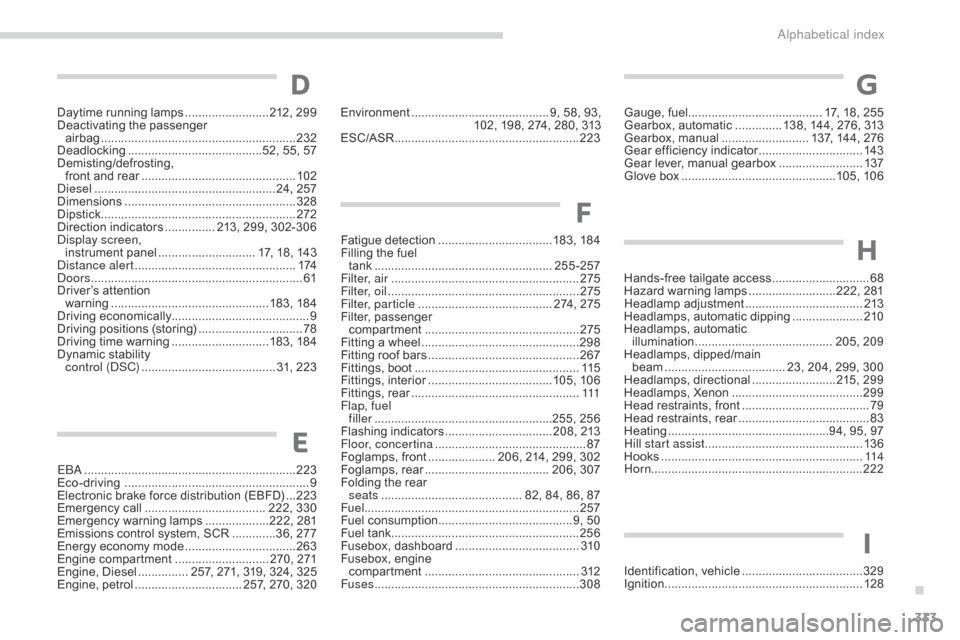
333
D
Daytime running lamps .........................212, 299
Deactivating t he p assenger
ai
rbag
.......................................................... 2
32
Deadlocking
...............................
.........52, 55, 57
Demisting/defrosting,
f
ront and rear
...............................
...............102
Diesel
...............................
.......................24, 257
Dimensions
..............................
.....................328
Dipstick
................
.......................................... 272
Direction
i
ndicators
............... 2
13, 299, 302-306
Display screen, instrument
pan
el
............................. 1
7, 18, 143
Distance alert
...............................
.................174
Doors
..............................................................
.61
Driver’s
attention
warning
...............................
................183,
18
4
Driving
e
conomically ......................................... 9
Driving
positions (storing)
...............................78
D
riving time warning
.............................18
3,
18
4
Dynamic
s
tability
c
ontrol (DSC)
........................................ 3
1, 223
EBA
.............................................................
..223
Eco-driving
...............................
........................ 9
Electronic
brake force distribution (EBFD)
...2
23
Emergency
c
all
.................................... 2
22, 330
Emergency
w
arning
lam
ps
...................2
22, 281
Emissions
control system, SCR
.............3
6, 277
Energy
economy mode
.................................26
3
Engine
c
ompartment
............................ 2
70, 271
Engine,
Diesel
............... 2
57, 271, 319, 324, 325
Engine,
petrol
................................ 2
57, 270, 320
F
Fatigue detection ..................................183, 18 4
Filling the fuel
tank
..................................................... 25
5-257
Filter, air
...............
......................................... 275
Filter, oil
......................................................... 2
75
Filter, particle
........................................ 2
74, 275
Filter,
p
assenger
c
ompartment
.............................................. 2
75
Fitting
a wheel
...............................
................298
Fitting
roof bars
............................................. 2
67
Fittings,
boot
................................................. 11
5
Fittings,
in
terior
..................................... 10
5,
10
6
Fittings,
r
ear
...............................
...................111
Flap, fuel filler
........
.............................................255, 256
Flashing
in
dicators
................................2
08, 213
Floor, concertina
............................................. 87
F
oglamps,
f
ront
.................... 2
06, 214, 299, 302
Foglamps,
re
ar
..................................... 2
06, 307
Folding
the rear
seats
...............
........................... 82, 84, 86, 87
Fuel ................................................................ 257
Fuel
c
onsumption
........................................9
, 50
Fuel
tank........................................................ 256
Fusebox,
das
hboard
..................................... 3
10
Fusebox,
eng
ine
c
ompartment
.............................................. 3
12
Fuses
................
............................................. 308
E
Environment ............................... .......... 9, 58, 93,
102, 198, 274, 280, 313
ESC/ASR
...............................
........................223Gauge,
fuel........................................ 17, 18, 255
Gearbox, automatic .............. 1 38, 144, 276, 313
Gearbox,
m
anual
.......................... 1
37, 144, 276
Gear
efficiency indicator
...............................14
3
Gear
lever, manual gearbox
.........................13
7
Glove
box
..............................................10
5,
10
6
Hands-free
tailgate access
.............................68
H
azard
w
arning
lam
ps
..........................2
22, 281
He
adlamp
adj
ustment
...................................2
13
Headlamps,
automatic dipping
.....................2
10
Headlamps,
automatic
illumination
...............................
.......... 205, 209
Headlamps,
d
ipped/main
b
eam
...............
..................... 23, 204, 299, 300
Headlamps,
d
irectional
.........................2
15, 299
Headlamps,
Xenon
.......................................29
9
Head
restraints, front
......................................79
H
ead restraints, rear
.......................................83
H
eating
................
................................94, 95, 97
Hill start assist
...............................................13
6
Hooks
...............................
.............................114
Horn ............................................................... 222
H
G
Identification, vehicle .................................... 32 9
Ignition ................ ........................................... 128
I
.
Alphabetical index
Page 348 of 523
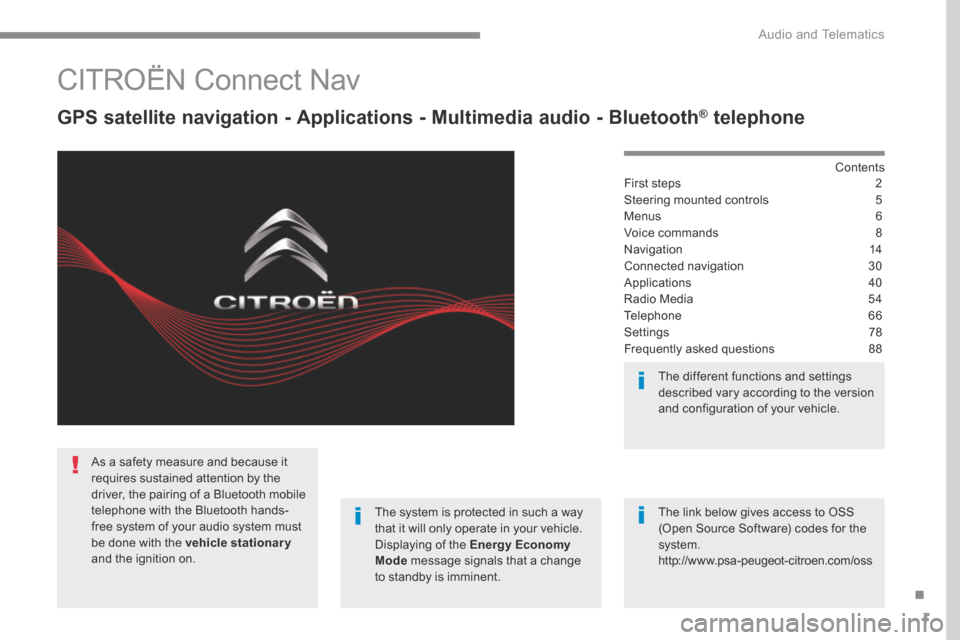
1
.
Audio and Telematics
CITROËN Connect Nav
GPS satellite navigation - Applications - Multimedia audio - Bluetooth ® GPS satellite navigation - Applications - Multimedia audio - Bluetooth ® GPS satellite navigation - Applications - Multimedia audio - Bluetooth telephone ® telephone ®
Contents First steps 2
Steering mounted controls 5
Menus 6
Voice commands 8
Navigation 14
Connected navigation 30
Applications 40
Radio Media 54
Telephone 66
Settings 78
Frequently asked questions 88
The system is protected in such a way that it will only operate in your vehicle. Displaying of the Energy Economy Mode message signals that a change to standby is imminent.
The different functions and settings described vary according to the version and configuration of your vehicle.
The link below gives access to OSS (Open Source Software) codes for the system. http://www.psa-peugeot-citroen.com/oss
As a safety measure and because it requires sustained attention by the driver, the pairing of a Bluetooth mobile telephone with the Bluetooth hands-free system of your audio system must be done with the vehicle stationaryand the ignition on.
Page 355 of 523
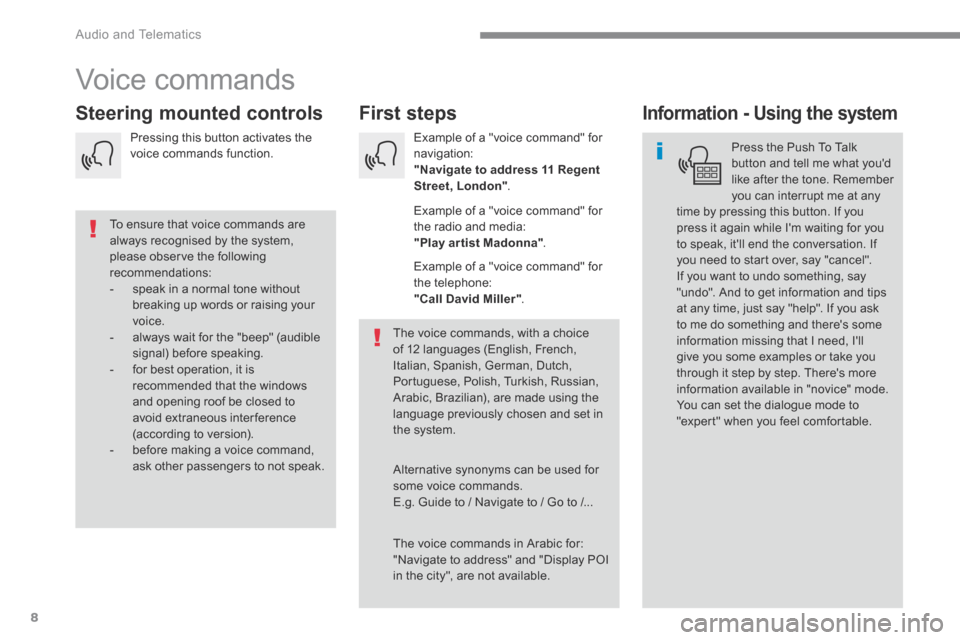
8
Audio and Telematics
Voice commands
First steps Steering mounted controls Information - Using the system
Press the Push To Talk button and tell me what you'd like after the tone. Remember you can interrupt me at any time by pressing this button. If you
press it again while I'm waiting for you to speak, it'll end the conversation. If you need to start over, say "cancel". If you want to undo something, say "undo". And to get information and tips at any time, just say "help". If you ask to me do something and there's some information missing that I need, I'll give you some examples or take you through it step by step. There's more information available in "novice" mode. You can set the dialogue mode to "expert" when you feel comfortable.
To ensure that voice commands are always recognised by the system, please observe the following recommendations: - speak in a normal tone without breaking up words or raising your voice. - always wait for the "beep" (audible signal) before speaking. - for best operation, it is recommended that the windows and opening roof be closed to avoid extraneous interference (according to version). - before making a voice command, ask other passengers to not speak.
The voice commands, with a choice of 12 languages (English, French, Italian, Spanish, German, Dutch, Portuguese, Polish, Turkish, Russian, Arabic, Brazilian), are made using the language previously chosen and set in the system.
The voice commands in Arabic for: "Navigate to address" and "Display POI in the city", are not available.
Alternative synonyms can be used for some voice commands. E.g. Guide to / Navigate to / Go to /...
Example of a "voice command" for navigation: "Navigate to address 11 Regent Street, London" .
Example of a "voice command" for the radio and media: "Play ar tist Madonna" .
Example of a "voice command" for the telephone: "Call David Miller" .
Pressing this button activates the voice commands function.
Page 378 of 523

31
.
Audio and Telematics
As a safety measure and because it requires sustained attention by the driver, using a smartphone when driving is prohibited. All operations must be done with the
vehicle stationary . vehicle stationary . vehicle stationary
Connected navigation connection
The principles and standards are constantly changing. For communication between your smartphone and the system to operate correctly, we recommend that you keep your smar tphone's operating system up to date, and the time and date on your smar tphone and the system correct.
The services offered with connected navigation are as follows. A Connected Services pack: - Weather, - Filling stations, - Car park, - Traffic, - POI, local search. A Danger area pack (option).
Activate the Bluetooth function on the telephone and ensure that it is visible to all (see the "Connect-App" section).
Connect the USB cable. The smartphone is in charge mode when connected by USB cable.
The system is automatically connected to the modem included for the "Emergency or assistance calls" services and does not require a connection provided by the user via
their smartphone.
On the arrival of "TOMTOM TR AFFIC", the services are available.
For access to connected navigation, you can use the connection provided by the vehicle via the "Emergency or assistance call" services or use your smartphone as a modem. Activate and enter settings for sharing the smartphone connection.
Restrictions of use: - With CarPlay ® , connection sharing is only with a Wi-Fi connection. - W i t h M i r r o r L i n k TM , connection sharing is only with a USB connection.
The quality of services depends on the quality of the network connection.
Select a Wi-Fi connection found by the system and connect to it (see the "Connect-App" section).
USB connection
Network connection provided by the vehicle
Network connection provided by the user
Bluetooth connection
Wi-Fi connection
Page 390 of 523

43
.
2
Audio and Telematics
As a safety measure and because it requires the sustained attention of the driver, using a smartphone when driving is prohibited. Operation must be with the vehicle stationary . stationary . stationary
The synchronisation of a smartphone allows applications on a smartphone that are adapted to the CarPlay ® technology ® technology ®
to be displayed in the vehicle's screen, having first activated the CarPlay ® function in the smartphone. As the principles and standards are constantly changing, it is recommended that you keep your smar tphone's operating system updated . For the list of eligible smartphones, go to the Brand's internet website in your c o unt r y.
Connect a USB cable. The smartphone charges when connected by a USB cable.
Connect a USB cable. The smartphone charges when connecte d by a USB cable.
Press " Telephone " to display the CarPlay ® inter face. ® inter face. ®
Press " CarPlay " to display the CarPlay ® inter face ® inter face ®
On connecting the USB cable, the CarPlay ® function deactivates the ® function deactivates the ®
system's Bluetooth ® mode. ® mode. ®
In the system, press " Applications " to display the primary page.
Or
Press " Connectivity " to go to the CarPlay ® function. ® function. ®
Page 400 of 523
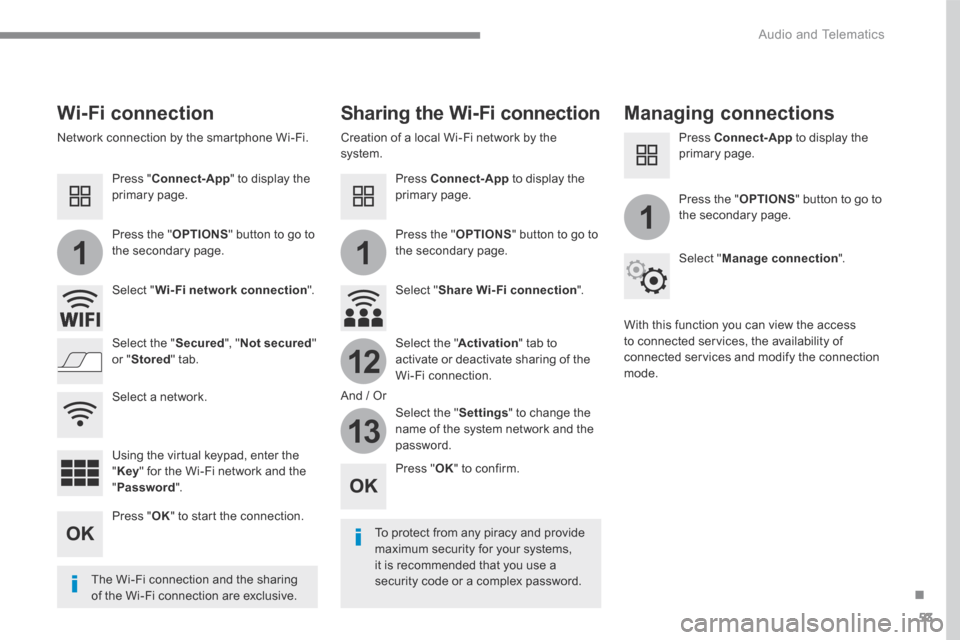
53
.
11
1
12
13
Audio and Telematics
Wi-Fi connection Sharing the Wi-Fi connection Managing connections
To protect from any piracy and provide maximum security for your systems, it is recommended that you use a security code or a complex password. The Wi-Fi connection and the sharing
of the Wi-Fi connection are exclusive.
Press " OK " to confirm.
Press " OK " to start the connection.
Press " Connect-App " to display the primary page.
Network connection by the smartphone Wi-Fi. Creation of a local Wi-Fi network by the system.
Press Connect-App to display the primary page.
Press Connect-App to display the primary page.
Press the " OPTIONS " button to go to the secondary page. Press the " OPTIONS " button to go to the secondary page.
Press the " OPTIONS " button to go to the secondary page.
Select " Wi-Fi network connection ". Select " Share Wi-Fi connection ".
Select " Manage connection ".
And / Or
Select the " Secured ", " Not secured " or " Stored " tab. Select the " Activation " tab to activate or deactivate sharing of the Wi-Fi connection.
Select the " Settings " to change the name of the system network and the password.
With this function you can view the access to connected services, the availability of connected services and modify the connection mode.
Using the virtual keypad, enter the " Key " for the Wi-Fi network and the " Password ".
Select a network.
Page 408 of 523
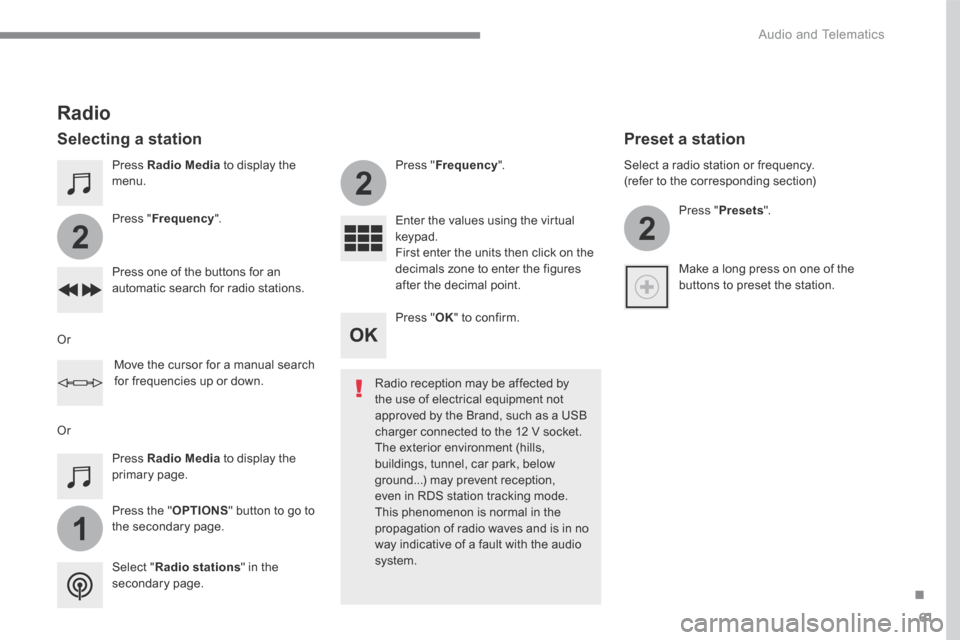
61
.
1
2
2
2
Audio and Telematics
Press Radio Media to display the menu.
Press the " OPTIONS " button to go to the secondary page.
Press " Frequency ".
Press " Frequency ".
Enter the values using the virtual keypad. First enter the units then click on the decimals zone to enter the figures after the decimal point. Press one of the buttons for an automatic search for radio stations.
Press Radio Media to display the primary page.
Radio
Selecting a station
Radio reception may be affected by the use of electrical equipment not approved by the Brand, such as a USB
charger connected to the 12 V socket. The exterior environment (hills, buildings, tunnel, car park, below ground...) may prevent reception, even in RDS station tracking mode. This phenomenon is normal in the propagation of radio waves and is in no way indicative of a fault with the audio system. Select " Radio stations " in the secondary page.
Or
Or
Move the cursor for a manual search for frequencies up or down.
Select a radio station or frequency. (refer to the corresponding section)
Press " Presets ".
Make a long press on one of the buttons to preset the station.
Preset a station
Press " OK " to confirm.
Page 411 of 523
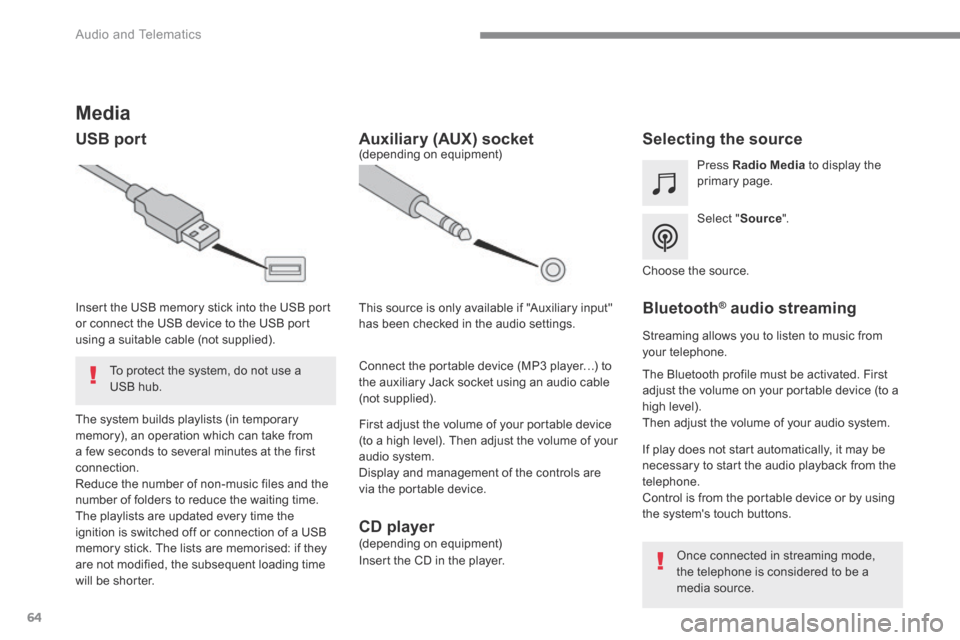
64
Audio and Telematics
Media
USB port Selecting the source
Select " Source ".
Press Radio Media to display the primary page.
The system builds playlists (in temporary memory), an operation which can take from a few seconds to several minutes at the first connection. Reduce the number of non-music files and the number of folders to reduce the waiting time. The playlists are updated every time the ignition is switched off or connection of a USB memory stick. The lists are memorised: if they are not modified, the subsequent loading time will be shorter.
Insert the USB memory stick into the USB port or connect the USB device to the USB port using a suitable cable (not supplied).
Auxiliary (AUX) socket
First adjust the volume of your portable device (to a high level). Then adjust the volume of your audio system. Display and management of the controls are via the portable device.
This source is only available if "Auxiliary input" has been checked in the audio settings.
(depending on equipment)
Connect the portable device (MP3 player…) to the auxiliary Jack socket using an audio cable (not supplied).
Choose the source.
Bluetooth ® Bluetooth ® Bluetooth audio streaming ® audio streaming ®
Streaming allows you to listen to music from your telephone.
The Bluetooth profile must be activated. First adjust the volume on your portable device (to a high level). Then adjust the volume of your audio system.
If play does not start automatically, it may be necessary to start the audio playback from the telephone. Control is from the portable device or by using the system's touch buttons.
Once connected in streaming mode, the telephone is considered to be a media source.
To protect the system, do not use a USB hub.
CD player (depending on equipment)
Insert the CD in the player.
Page 412 of 523
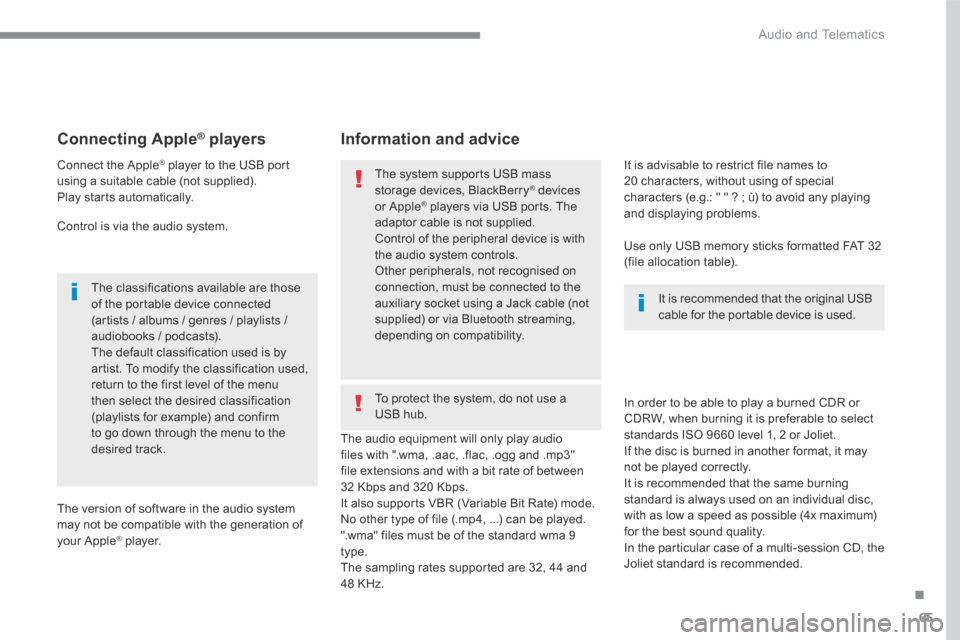
65
.
Audio and Telematics
Connecting Apple ® Connecting Apple ® Connecting Apple players ® players ®
Connect the Apple ® player to the USB port ® player to the USB port ®
using a suitable cable (not supplied). Play starts automatically.
Control is via the audio system.
The classifications available are those of the portable device connected (artists / albums / genres / playlists / audiobooks / podcasts). The default classification used is by artist. To modify the classification used, return to the first level of the menu then select the desired classification (playlists for example) and confirm to go down through the menu to the desired track.
The version of software in the audio system may not be compatible with the generation of your Apple ® player. ® player. ®
The audio equipment will only play audio files with ".wma, .aac, .flac, .ogg and .mp3" file extensions and with a bit rate of between 32 Kbps and 320 Kbps. It also supports VBR (Variable Bit Rate) mode. No other type of file (.mp4, ...) can be played. ".wma" files must be of the standard wma 9 type. The sampling rates supported are 32, 44 and 48 KHz.
In order to be able to play a burned CDR or CDRW, when burning it is preferable to select
standards ISO 9660 level 1, 2 or Joliet. If the disc is burned in another format, it may not be played correctly. It is recommended that the same burning standard is always used on an individual disc, with as low a speed as possible (4x maximum) for the best sound quality. In the particular case of a multi-session CD, the Joliet standard is recommended.
It is advisable to restrict file names to 20 characters, without using of special characters (e.g.: " " ? ; ù) to avoid any playing and displaying problems.
Information and advice
Use only USB memory sticks formatted FAT 32 (file allocation table).
The system supports USB mass storage devices, BlackBerry ® devices ® devices ®
or Apple ® players via USB ports. The ® players via USB ports. The ®
adaptor cable is not supplied.
Control of the peripheral device is with the audio system controls. Other peripherals, not recognised on connection, must be connected to the auxiliary socket using a Jack cable (not supplied) or via Bluetooth streaming, depending on compatibility.
It is recommended that the original USB cable for the portable device is used.
To protect the system, do not use a USB hub.